Table of contents:
Benefits of AR Apps Development
SDKs for AR Apps: Comparison Table
AR Apps Features and Development Cost
With the rising popularity of AR, more businesses want to implement AR/VR development services and reap the benefits of AR apps. But how can you budget for AR development when you’re not sure what will affect Augmented Reality app development cost?
Benefits of AR Apps Development
SDKs for AR Apps: Comparison Table
AR Apps Features and Development Cost
In this article we will sort out the following:
And some bonus content: We’ll answer some frequently asked questions about building an AR app at the end of the article. Read on!
Augmented Reality is a technology that overlays digital content on a real-world image. The overlay may consist of graphic content of different kinds: 3D and 2D objects, masks with object and motion tracking, interactive objects such as buttons, and so on.
Usually, AR experiences include sound content as well.
Some simple points about how AR apps work:

Thanks to the fact that most AR apps require only a smartphone to run, AR technologies are very affordable to both parties:
Brands take advantage of this affordability by building an AR app for smartphones. Let’s take a look at some successful AR platform use cases.
Many industries benefit from building an AR app, but some can completely change how their business operates by taking advantage of AR.
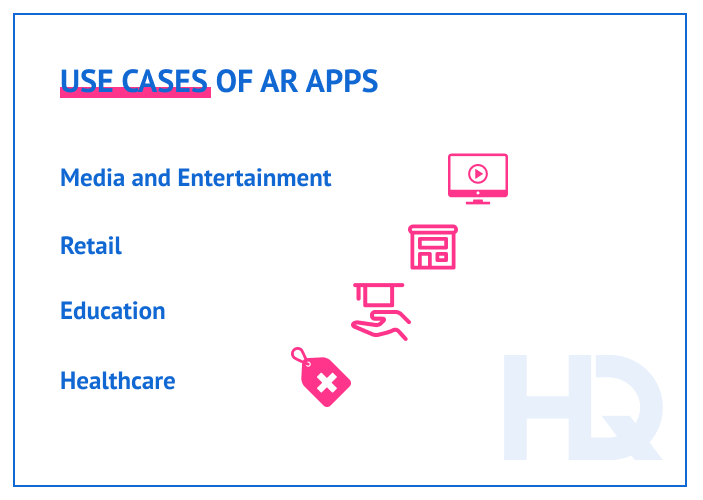
We will discuss these industries below.
Media and entertainment businesses decide to create an AR app with the goal of dominating their industry.
It’s no secret that traditional gaming doesn’t impress anymore, and gamers are seeking new ways of entertaining themselves. That’s why the AR gaming market is expected to reach $284.9 billion by 2023 and will continue to grow further.
Social media platforms such as Instagram, TikTok, and Snapchat provide users with AR content such as face masks, graphic content for videos and photos, and even games.
How do modern businesses use AR to increase their revenues and outperform their industry competitors?

For example, TikTok released the first-ever LiDAR-powered AR effect. With the help of LiDAR, effects bring together real and virtual worlds; the position of real objects is pre-analyzed so that graphic objects blend smoothly with interiors.
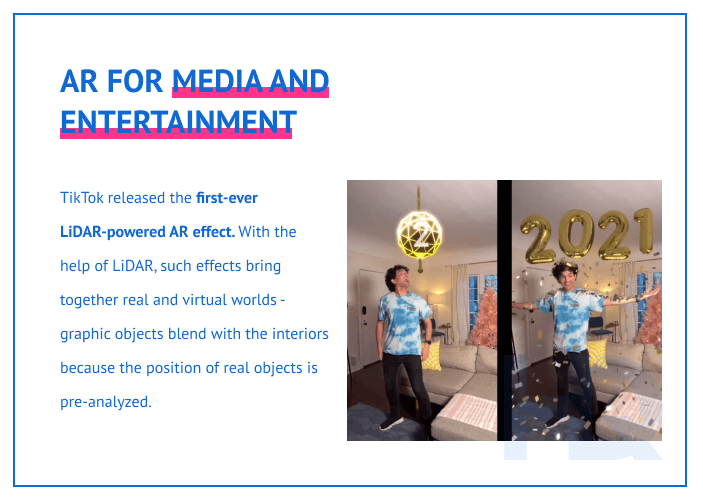
Retail businesses benefit from the ability of AR platforms to overlay 3D and 2D content on particular objects from real life. We’re talking, for example, about fitting clothes on human bodies virtually.
One of HQSoftware’s successful projects, PiCTOFIT, for example, has thrived on this concept. By building an AR app , the business gives shoppers the chance to create a virtual avatar who tries on the clothing.

The app has boosted sales by attracting customers who love the experience of seeing how they’ll look in the clothes right from their phone, before they buy.
AR is great not only for entertainment but also for educational purposes. AR can be used to teach everyone from preschoolers to higher education students.
For example, there are tons of AR apps on the market with educational content on narrow topics that will be much more engaging for children than merely reading an article.
The Ocean 4D+ app is an AR application featuring ocean creatures that shows:

For more mature students, there are entirely AR-based educational programs used mostly in healthcare education.
The Virtual Anatomy Simulator is a powerful application used to teach students human body anatomy with the help of 3D visualization of a real body.
The app teaches concepts of anatomy, physiology, muscles, and more.
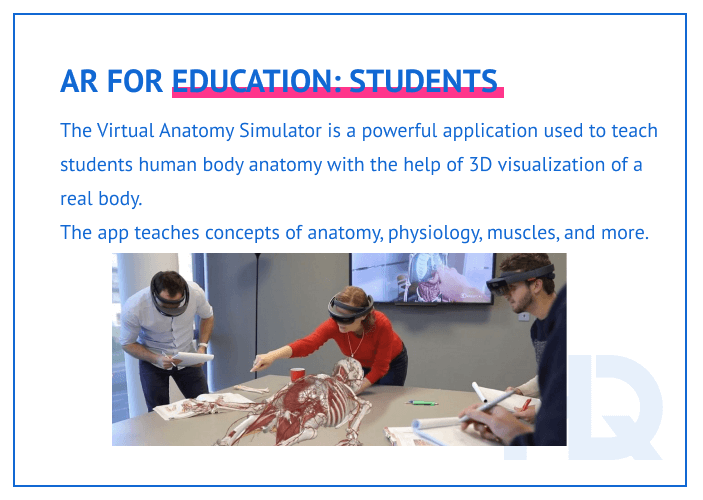
One of the most impressive ways AR is used for healthcare is hands-free surgical assistance.
A surgeon can wear AR glasses and get remote assistance with graphic hints and overlaying data without any distractions. See how Augmedics handles this — they have even built an AR head-mounted display for surgical purposes.

As you can see, each industry uses AR in a different way, but regardless of the field, this technology offers businesses numerous benefits.
In the table below we have described the features and benefits of AR applications for various industries.
| Industries | AR app development benefits |
| Media and entertainment | Customer engagement. As AR seamlessly connects elements of real and virtual worlds and allows interactions with both, users can actively engage with entertainment content and take part in activities instead of being passive observers.
Immersive experience. With interactive ads, games, and social media materials, businesses attract users’ attention, immerse them in content consumption, and create truly memorable experiences. Content diversification. By adding interactive virtual elements, companies can diversify their conventional static forms of content to enhance the customer experience. |
| Retail | Boosting sales. AR allows customers to virtually try on products before purchase, which enhances decision-making and reduces returns.
Improving the customer journey. The ability to interact with products, explore them in detail, and easily receive additional information about them makes shopping more engaging and enhances the customer experience. Increasing customer retention. Using AR, businesses can optimize every touchpoint with buyers, which, together with an interactive shopping experience, creates a positive brand image and encourages customers to make recurring purchases. Providing personalized content. AR apps collect data on shoppers’ behavior and preferences, which then enables personalized experiences and product recommendations that immerse customers in shopping and lead to increased sales. |
| Education | Interactive learning environment. Using AR apps, students can augment existing reality and interact with virtual objects, which engages them in the learning process.
Immersive learning. AR technology allows learners to gain practical skills in a safe virtual environment without having to buy or use expensive equipment. Enhanced memorization. Adding visuals and providing opportunities to interact with learning material helps students better understand the subject and, as a result, absorb it better. Accessibility. Students can use AR apps for learning whenever and wherever they want, which makes studying accessible for learners from various locations. |
| Healthcare | Improved training. AR technology helps medical students memorize information better, using 3D models instead of 2D images. Doctors, in turn, can improve their surgical performance on virtual patients.
Enhanced surgical efficiency. Using AR, surgeons can overlay scan results on the patient’s body, which helps them during surgery. It’s especially helpful for use with laparoscopic or minimally invasive surgeries. Advanced patient consultation. This is a win-win for both parties: doctors can better visualize patient data and even conduct remote consultations, while patients can better understand information related to their medical condition. |
The aforementioned benefits not only vary from industry to industry but also depend on the type of AR application that’s being used. So, when thinking about building an AR app, businesses must first decide which of the three types of AR is best suited to the project.
There are three types of AR platforms:
Let’s take a closer look at these choices.
Want to upgrade your business with an AR app?You have found your perfect partner here – HQSoftware is ready to develop a perfect AR app that will take your business to a new level.
Anna Halias
Business Development Manager,
HQSoftware
A marker-based AR app requires a visual trigger and some prior knowledge of the user’s environment to start the experience and place it correctly.
In simple words, a user needs to scan a marker — usually, it’s a 2D printed image — and when the AR app recognizes it, the experience starts.
This format suits businesses whose target is to offer a simple experience that will work correctly upon scanning a marker.
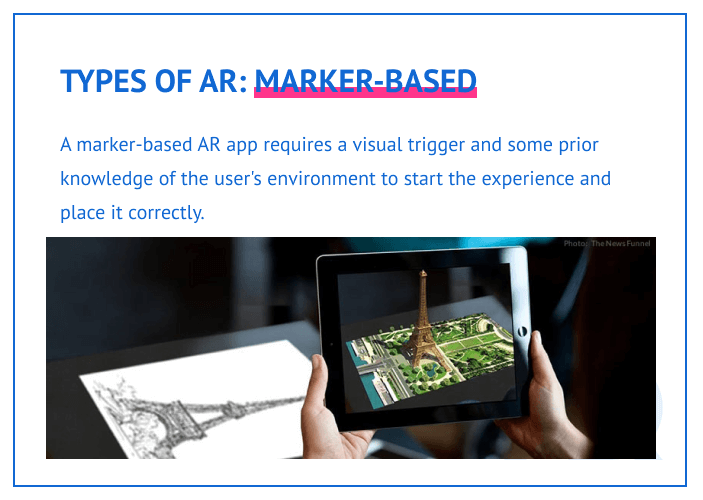
For example, the user scans a code on a business card and gets an AR experience that showcases information about the company via digital content. See how HQSoftware did this with its own business cards.
A markerless AR app does not need a visual trigger to start the experience. It will be placed over some object seen through a camera. Usually, this is a flat surface, like a floor or walls, a human’s face, etc.
This type of AR doesn’t need to scan the environment beforehand. It just uses the data from the camera and built-in sensors in the smartphone.
An AR face filter, or an app that places virtual furniture in your apartment, are good examples of this type. Check out the AR masks on Instagram or Ikea Place for reference.
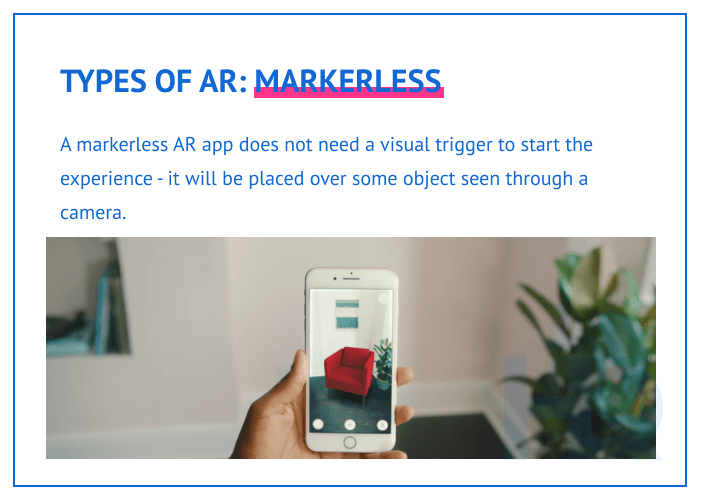
A location-based AR app obtains data from the device’s accelerometer, compass, and GPS data to identify where the user is located and check whether it is a Point of Interest.
When the location is identified and it is the right one for the experience, the AR app starts the experience. It doesn’t usually rely on flat surfaces.
The most famous example is Pokemon GO — an AR game that became a worldwide phenomenon, where the user must catch pokemon located in different places around a city.

To create an AR app of any type, developers use SDKs — software development kits. Let’s take a look at the most popular ones and compare them.
Let’s compare 4 of the most popular AR SDKs:
| ARCore | ARKit | Kudan | EasyAR | |
| Type | Free API | Free API | Free, commercial option available | Free, commercial option available |
| Unity 3D | + | + | + | + |
| Face tracking | + | + | Needs plugins | Needs plugins |
| Object tracking | + | + | + | + |
| Deployment platform | Android | iOS | Android/iOS | Android/iOS |
| Cloud recognition | – | – | + | + |
Next, let’s break down the AR development costs.
Let’s start with some typical development approaches:
And some typical features:
From here we will analyze the Augmented Reality app development cost for these 6 options.
To calculate all further AR development costs, we’ll take an average developer rate of $35 per hour, which is common in countries such as Estonia and Estonian that boast high-quality development services.
An AR MVP will help you test your idea and decide whether it is worth developing a whole AR platform. MVPs are generally lightweight, user-friendly, and carry few features: virtual models that users can rotate and zoom, and that might be it.
In this case, the whole process from designing and wireframing to development and publishing in app stores will take around 65 hours. With a small team of 2 developers, 1 tester, 1 designer, and 1 3D modeler, the AR app development costs will be up to $11,400.

A custom AR application could include an unlimited number of features, but we will stop with a few of them.
A simple custom AR application will probably include the following features:
This set will take up to 100 hours, depending on the complexity of features. With the same team composition as was stated earlier, the AR app cost will be around $63,000.
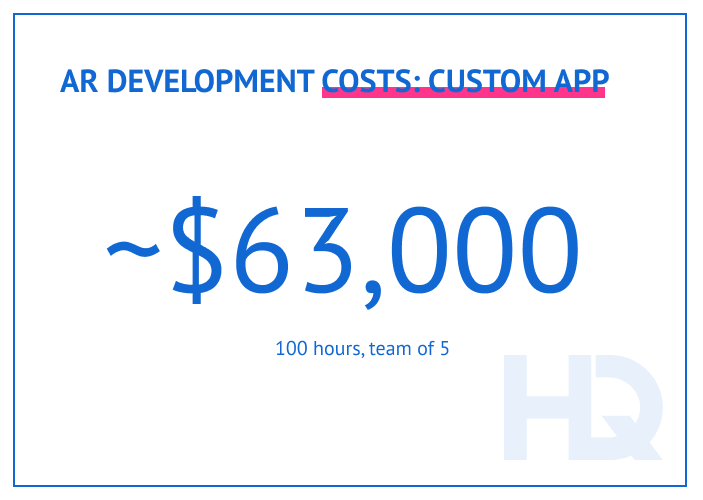
Enterprise AR applications simultaneously satisfy a number of potential business objectives. They may offer features for employee training, cooperative work, inventory tracking, and so on.
A standard set of features for this type of AR app will include:
With publishing to app stores, building an AR app for enterprise takes a minimum of $38,000. At the upper end, the sky is the limit. The final AR app development price depends on the complexity of the project, number of features, and team composition.
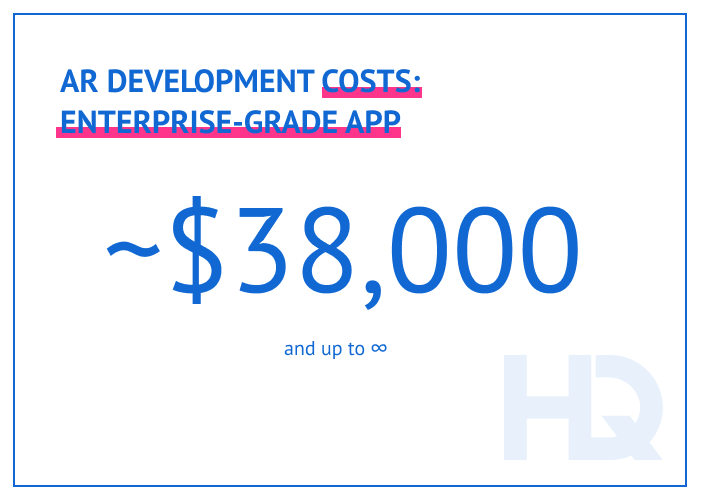
Marker-based AR apps need a visual code that triggers the AR experience. Typically such apps are simple and can be developed in a short time.
It can take around 100 hours to build an AR app and will cost around $3,000.
Markerless AR is a more complex technology that requires extra effort when building an AR app.
It typically takes up to 500 hours of development and design, and the cost of building an Augmented Reality app of this type starts at $10,000.
Geolocation-based AR apps often require a cloud connection to download AR content from the server to show it to users. Such apps have more features, are more complex, and require a larger team.
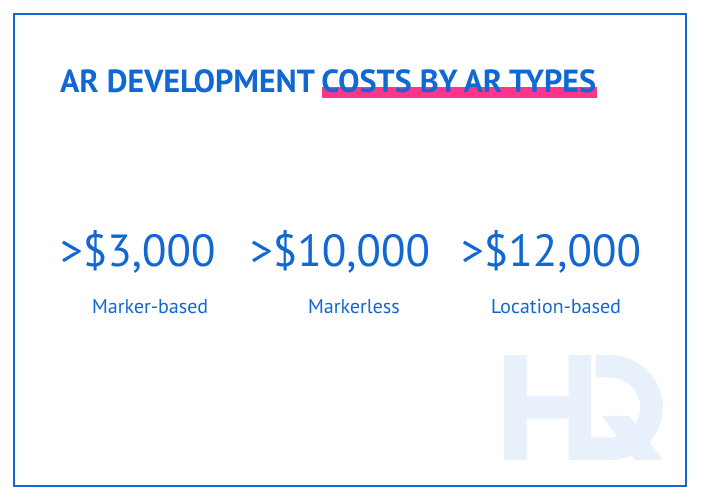
It takes more than 400 hours to build such an app. The AR app development cost will start at $12,000.
Note that all of these cost estimations are extremely approximate. To learn how much it will cost to develop an Augmented Reality app for your specific needs, contact us for a free estimate.
We have partly described these costs already, but let’s dive in a little deeper
An AR development team can include the following specialists:
If you have to hire a complete team, or the project requires more than just two developers, it will cost more.
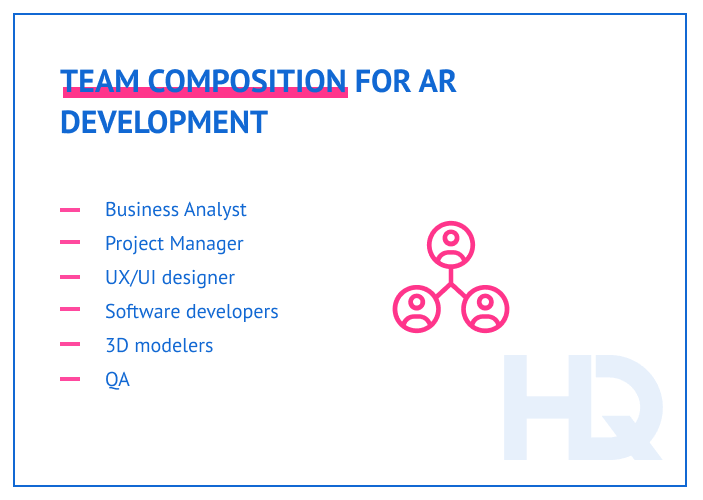
You can have a Project Manager, or a Business Analyst, or both, coming from your business, without needing to hire them from a vendor. This will save you some money but can complicate the development process.
An hourly rate is the price a client pays for an hour of work of one specialist. Rates depend on the experience of a specialist, their position, and their location.
For example: according to Upwork, Unity developers from junior to senior levels cost $15-$75 respectively. According to Payscale, the average hourly rate in the USA is $39.55, and in Spain, it is around $25.
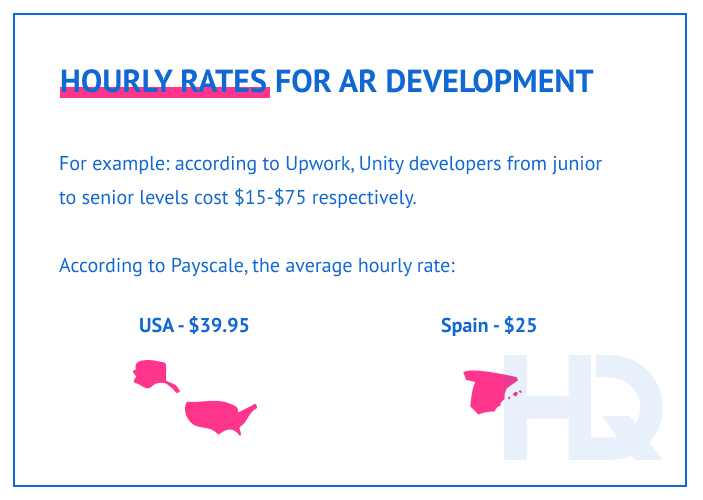
AR app development costs will differ drastically depending on the project type you choose.
Creating an AR app with only a few 3D models and a marker will take little time and, of course, cost less than building an enterprise-grade AR system.
Geolocation-based AR also costs more than other types of AR.
Here, the rule is simple — the more features required, the higher the cost. Also, features take varying amounts of time to build.
Creating 3D content for AR experiences is a whole separate issue. It takes time and money and often requires a whole bunch of developers working simultaneously.
Now that you know all the variables, let’s figure out what your AR app cost might be.
Because there are so many factors affecting the AR app development price, we will try to create a rough estimate using the information already shared in this article.
For a complex AR app with, let’s say, several markers, social media sharing features, a content gallery, and so on, it will take more than 160 hours of development.
Here we will also add around 100 hours of Business Analysis, Project Management, 3D design, and QA work.
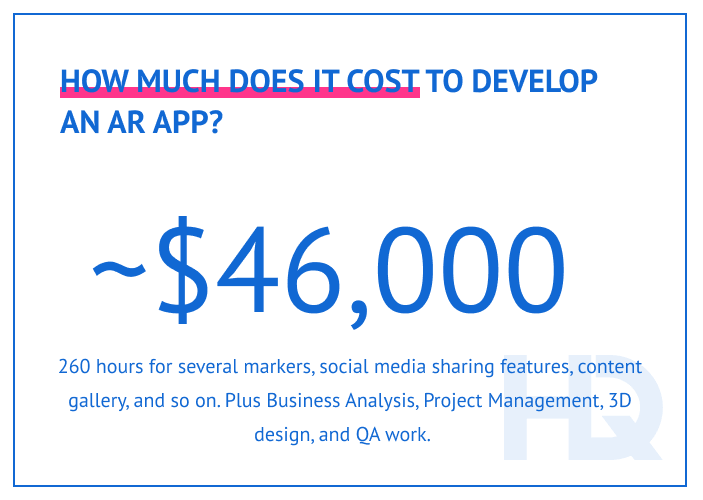
As a result, building an AR app will take around 260 hours, and the cost of app development with the aforementioned features will be around $46,000.
To determine an AR app development cost for your business, drop us a line — we will create a free personal estimate for you.
We are open to seeing your business needs and determining the best solution. Complete this form, and receive a free personalized proposal from your dedicated manager.

Sergei Vardomatski
Founder